Contents
Far from all varieties of tomatoes can withstand the Ural and Siberian climate. Local gardeners are forced to choose from zoned varieties and hybrids that are more cold-resistant and hardy. This category also includes one of the recent achievements of breeders – the Siberian dwarf tomato. There is not yet much experience in its cultivation, but the novelty is considered promising.
The story of
Tomatoes Siberian dwarf went on sale in 2018. The originator is the Novosibirsk agricultural company Sibirsky Sad, which specializes in crops adapted to local climatic conditions.
But the original variety was quickly appreciated by gardeners in other regions. “Stress resistance” and “plasticity” allow him to successfully adapt to a variety of features of the local climate, not to respond to the vagaries of the weather.
The variety is not yet listed in the domestic State Register. There is no information about whether the originator filed the corresponding application.

Siberian dwarf tomatoes are popular not only in Siberia
Description of the variety of tomato Siberian dwarf
At home, the Siberian dwarf is a medium-early tomato variety. It takes 100-105 days for the crop to mature from the moment the seedlings emerge from the seeds. But in more favorable conditions for gardening, tomatoes ripen faster – in 90-95 days. Therefore, in the middle lane and in the south of Our Country, the variety can be classified as early ripe.
The bushes are very compact, “squat”, 25-35 cm high. The variety is standard – it is characterized by the presence of a powerful stem, similar to a tree trunk. The leaves are relatively small, typical for tomatoes form. Dense foliage for bushes is uncharacteristic.
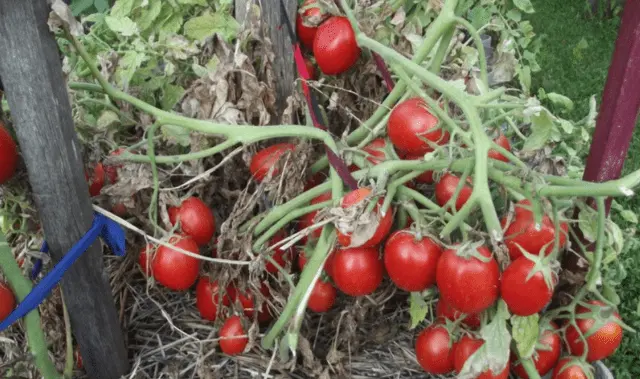
There is a place for Siberian dwarf tomato bushes even on the notorious “six acres”
Tomatoes are large compared to bushes. The average weight of Siberian dwarf tomatoes is 150-180 g, specimens weighing up to 200 g are often found.
The peel is quite strong, classic “tomato”-red color, with a glossy sheen. The pulp is dense, but fleshy, “grainy” on the cut. There are a maximum of 3-4 seed chambers, the seeds in them are small, almost imperceptible when eating. Taste qualities cannot be called outstanding, but they do not cause criticism either. The taste is not bad, balanced, with light notes of sweetness and noticeable sourness.
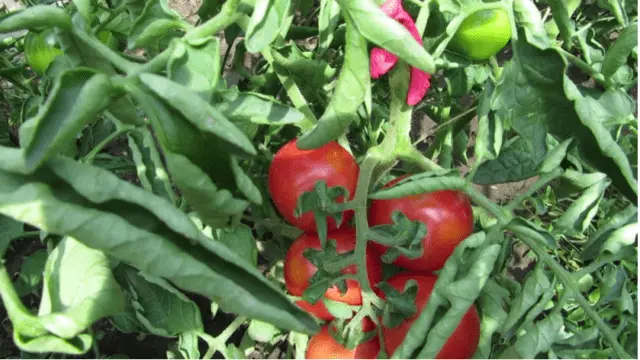
The shape of the tomatoes is regular, oval, with a slightly pointed tip.
Characteristics of the tomato Siberian dwarf
In general, the characteristics of Siberian dwarf tomatoes are standard for standard varieties. The main indicators that immediately attract the attention of gardeners are compact dimensions with high yields.
Tomato yield Siberian dwarf
Carpal type fruiting. Brushes (5-6 on each bush) are tied very often, through one or two sheets. This provides a high yield for plants with such modest dimensions – about 4 kg per bush per season.
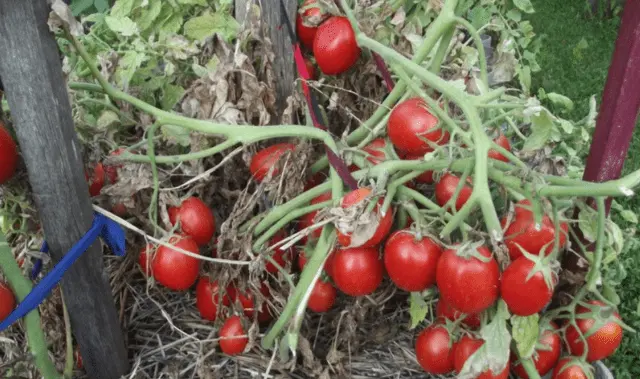
High yields of tomatoes Siberian dwarf due to carpal fruiting
Disease and pest resistance
The manufacturer does not provide information about the resistance of the Siberian dwarf tomato to pathogenic microflora and the presence of “innate” immunity to any diseases. But the practice of growing shows that the resistance to fungi and viruses in the variety is not bad.
Plants rarely suffer from diseases, even if the weather during the growing season is favorable for the development of pathogenic microflora. Due to the relatively short ripening period of the crop, the risk of infection with one of the most dangerous diseases for tomatoes, late blight, is minimized. It develops towards the end of summer. By this time, the entire crop of Siberian dwarf tomatoes is already being harvested, the bushes are being disposed of, like plant debris.
Methods of Use
Tomatoes Siberian dwarf are good fresh – in salads and cuts. They are also used for cooking first and second courses, sauces, homemade ketchup and tomato paste.
But only positive reviews receive homemade canned food. Tomatoes are completely placed in jars as a whole. When salting and pickling, the skin practically does not crack, retains the brightness of the color. The pulp also does not change the consistency.
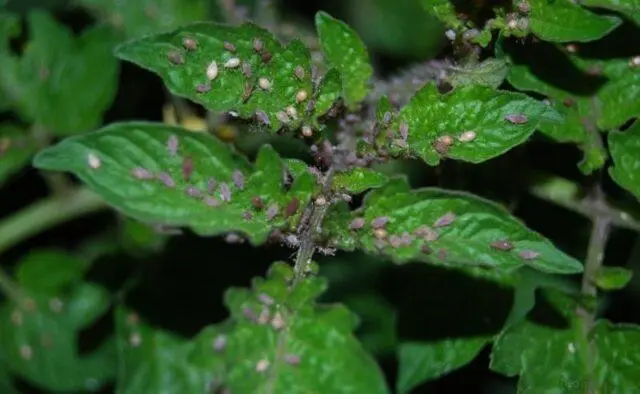
The only thing that cannot be done from the Siberian dwarf is to squeeze the juice
Advantages and disadvantages
Only having appeared on sale, the Siberian dwarf tomato quickly aroused steady interest among gardeners. This is due to a rather long list of its advantages:
- the possibility of cultivation in open and closed ground, at home;
- endurance and “plasticity” of plants (resistance to the vagaries of the weather, the ability to adapt to the local climate);
- simplicity of agricultural technology, unpretentiousness in care (the variety is suitable even for novice gardeners);
- undemanding to lighting during the cultivation of seedlings and after transplanting into the garden;
- good immunity;
- cultivation without tying, shaping and pinching;
- early terms and “mass character” of crop ripening;
- compactness of plants, which can significantly save space in the garden;
- high yield;
- external presentability, large-fruitedness, one-dimensionality of tomatoes;
- universal purpose of tomatoes, quite good taste;
- good transportability and keeping quality.
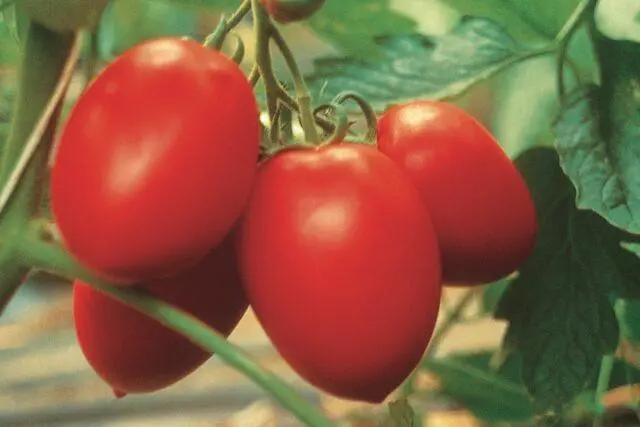
Standard tomatoes, as a rule, have a very mediocre taste, the Siberian dwarf is a successful exception.
So far, no obvious flaws have been found. Some gardeners note the need to regularly feed plants as a relative minus.
Since the variety is new, seeds are not always found on sale. Theoretically, they can be obtained from self-picked tomatoes, but in practice there are problems with this. There are very few seeds in Siberian dwarf tomatoes, the vast majority of them are underdeveloped.
Features of planting and care
Due to the peculiarities of the local climate, Siberian dwarf tomatoes, despite their precocity, are grown in seedlings. Plants with 3-4 true leaves take 5-6 weeks to develop. They are transplanted into the ground at the end of May or at the beginning of June, seeds for seedlings are sown in the second decade of April.
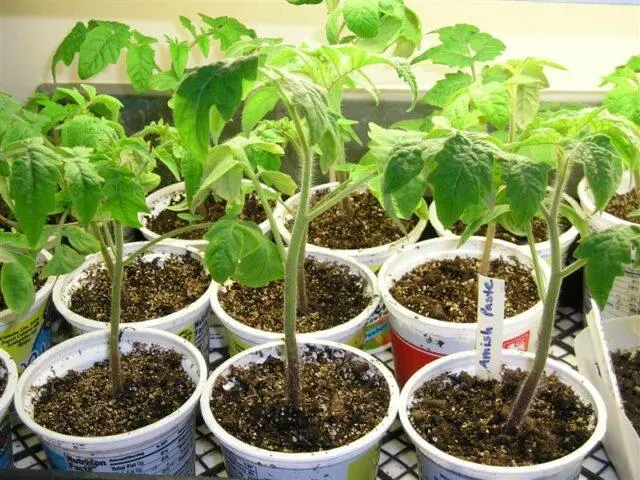
Pre-hardening seedlings facilitates adaptation to changing growing conditions
Good lighting is not the main requirement of the Siberian dwarf tomato to the landing site. Partial shade is also suitable for him. The quality of the substrate is more important – it must be fertile, but at the same time relatively “light” and loose. Acid-base balance – neutral or slightly acidic. Therefore, when the garden bed (10-12 days before planting the seedlings) is dug up, humus and complex fertilizer must be added to the soil.
The requirements for watering the variety are the same as for any standard tomatoes with a superficial root system. The “norm” per bush is about 3-4 liters, but the soil should not be allowed to dry out more than 2-3 cm deep. In the absence of precipitation, Siberian dwarf tomatoes are watered every 3-5 days.
Mulching is highly recommended. Mulch allows you to refuse loosening and weeding (the risk of damage to the roots in the process disappears). It also prevents the rapid evaporation of moisture from the soil.
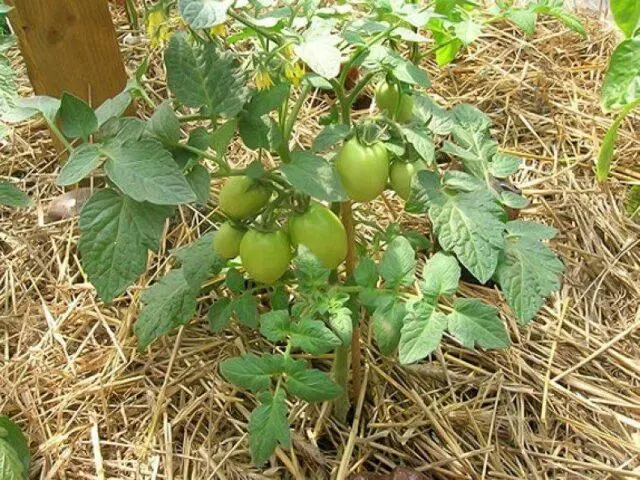
The bed is mulched immediately after planting tomato seedlings
Siberian dwarf tomatoes are fed three times:
- 8-10 days after planting seedlings in the ground;
- two weeks later;
- after harvesting the first “wave” of the crop.
The best option for this variety is complex purchased fertilizers for tomatoes. They provide Siberian dwarf tomatoes with nutrients in the right amount. Natural organics do not always cope with this task.
Siberian dwarf tomatoes do not need to form, remove stepchildren, even tying fruit brushes. Powerful plants can withstand the weight of ripening tomatoes.
Pest and disease control
The originating company in the description of the variety does not mention the presence of “innate” immunity to any diseases in Siberian dwarf tomatoes. The experience of growing them by amateur gardeners indicates that infection with pathogenic microflora for plants is an atypical phenomenon.
Tomatoes Siberian dwarf successfully resist pathogenic fungi, even if their “neighbors” in the garden “pick up the infection.” Therefore, it can be argued that in order to prevent the development of diseases, it is enough to follow the disembarkation scheme and follow the recommendations.

Tomato Siberian dwarf successfully avoids late blight infection
An additional preventive measure that many gardeners resort to is dressing seeds in a fungicide solution before planting seedlings. The same copper-containing preparations can be used to treat plants and soil in the beds, if the weather favors the development of diseases. Siberian dwarf tomatoes are processed every 1,5-2 weeks.
This variety is also not very interesting for pests. But in the event of a massive invasion of the aphid garden, it can also attack Siberian dwarf tomato bushes. They fight insects by spraying plants and soil with solutions of any universal insecticides. For prevention, you can powder the bushes with ground pepper, tobacco dust, wood ash.
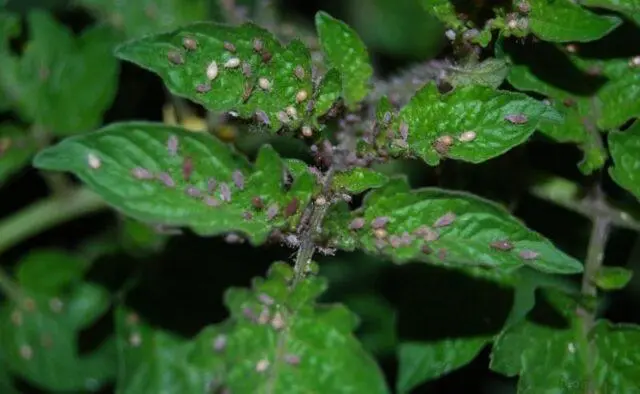
The aphids literally “cling around” tomato bushes, concentrating on fruit ovaries, buds, shoot tips
Conclusion
The Siberian dwarf tomato was specially created for the regions, the climatic conditions of which cannot be called ideal for gardening. The variety appeared on sale recently, but “consumers” have already appreciated it. The compactness of the bushes, high yield, large size and very good taste of the fruit are successfully combined with “stress resistance”, good immunity and ease of cultivation.









